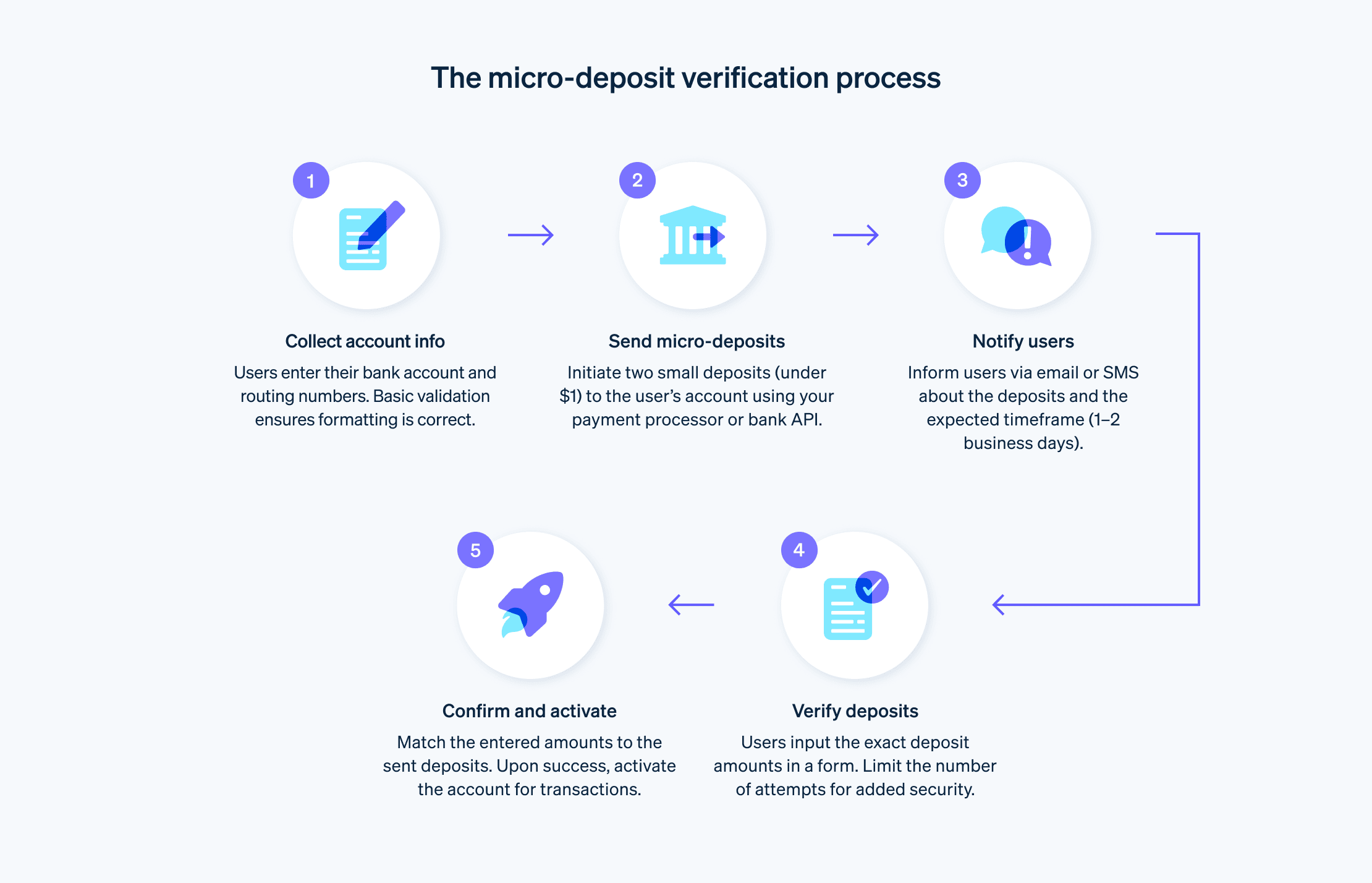小额存款验证是一种验证银行账户所有权的方法。小额存款等验证方法通过确认试图将银行账户与金融服务关联的人是该账户的授权持有人来降低欺诈风险。近三分之二的消费者表示非常或比较担心网上安全问题,这凸显了对小额存款验证等安全措施的高度需求。
本指南将介绍小额存款验证的工作原理,以及如何为商家实施小额存款验证。
本文内容
- 小额存款验证的工作原理
- 使用小额存款验证的好处
- 小额存款验证与其他验证方法的比较
- 如何使用 Stripe 进行小额存款验证
- 小额存款验证的逐步实施指南
- 验证流程的最佳实践
小额存款验证的工作原理
当用户将他们的银行账户与金融服务(如PayPal 、投资平台、点对点支付应用程序)建立新链接时,该服务会提示用户输入银行账户详细信息,如账号和路径号码。然后,该服务会在用户的银行账户中存入一笔或多笔小额存款——通常每笔存款少于一美元。用户的账户可能会收到一到两笔小额款项(例如,0.05 美元和 0.15 美元)。
小额存款出现在用户账户后,用户登录其银行账户,记下具体的存款金额。他们返回金融服务平台并输入这些金额,以确认他们可以访问银行账户。如果输入的金额与存款金额一致,则验证成功,金融服务将完全激活用户的账户,以便进行交易。
使用小额存款验证的好处
小额存款验证通过确保试图关联银行账户的人是该账户的所有者,从而预防欺诈。它还有助于履行"了解你的客户"(KYC)和反洗钱(AML)监管合规要求。虽然还有其他验证方法,但小额存款验证具有以下主要优点:
成本:_ 小额存款是一种低成本、直接的验证方法。
适用性: 小额存款几乎可以在任何可以接收转账的银行账户中使用,无论银行的规模或技术能力如何。
用户信任: 小额存款验证流程通过让客户积极参与验证流程,并使用熟悉的日常操作,能够增强用户的信任感。
流程: 与其他可能需要用户提交个人文件或接受信用检查的验证方法不同,小额存款验证的侵入性较低,除了检查银行交易外,不需要客户做更多的事情。
灵活性: 小额存款不要求账户持有人出现在特定的工作地点或使用特定设备。他们可以在任何可以访问网上银行或移动银行的地方完成验证。
小额存款验证与其他验证方法的比较
小额存款验证是验证银行账户所有权的几种方法之一。每种方法都满足不同的需求,并在安全性、速度、用户便利性和隐私之间进行权衡。选择哪种方法通常取决于金融服务及其客户的具体需求和优先事项。
以下是小额存款验证与其他验证方法的比较。
小额存款
金融服务向用户的银行账户中存入一笔或多笔小额存款(通常少于一美元)。用户确认存款的确切金额,以验证账户所有权。此方法具有高度安全性、广泛适用、无侵入性且经济实惠。但与某些其他方法相比,它较慢,因为存款可能需要 1-2 个工作日才能出现在用户账户中,并且需要用户检查账户并报告金额给金融服务。
通过登录凭证进行即时账户验证 (IAV)
用户将自己的网上银行账户凭证提供给第三方服务提供者,由后者代为登录,并即时验证账户详情。这是一种快捷方便的方法,但用户可能会对共享登录凭据感到担忧,而且如果第三方服务被攻击,也会存在潜在的安全风险。
银行 API 集成应用
API 直接与银行集成应用,实时获取账户信息并进行验证。这是一种快速且高度安全的方法,可提供详细的账户信息。但它需要银行有兼容的 API,这使得此方法仅限于某些银行或地区,而且实施起来可能比较复杂。
预验证支票或预通知支票
用户向自己或服务机构开具支票,支票详情(账户和支票上的路径号码)将用于验证账户。这一流程的速度取决于支票处理的速度。虽然对一些用户来说,这是一种熟悉的传统方法,但它比电子方法慢,容易受到欺诈风险影响,而且随着使用支票的人越来越少,这种方法逐渐过时。
信用查询
软查询或硬查询用于通过与账户详细信息的一致性来验证财务信息和身份。通常,这个过程可以即时完成,或者在同一个工作日内完成,并提供用户财务状况的全面信息。然而,硬查询可能会影响用户的信用评分,并且这种方法也引发了一些隐私问题。
如何使用 Stripe 进行小额存款验证
小额存款验证是 Stripe 用来验证银行账户的方法之一。它在涉及高风险交易的情境中或在即时验证选项不可用或不被广泛支持的地区特别有用,通常用于验证 ACH 支付的账户。下面是该流程的工作原理。
账户信息: 用户在 Stripe 平台上输入其银行账户详情,通常包括银行账号和路径号码。
存款: 用户提交银行账户信息后,Stripe 会向该银行账户存入两笔小额存款,通常每笔不到一美元。这些存款一般在 1-2 个工作日内处理完毕。
存款验证: 用户通过银行网站、银行应用程序或银行对账单查看自己的银行账户,以了解 Stripe 存款的具体金额。然后,用户返回 Stripe 管理平台,在 Stripe 提供的验证字段中输入两笔存款金额。
账户验证: 在确认用户输入的金额与小额存款相符后,Stripe 会验证银行账户。用户现在可以使用该银行账户来进行 ACH 交易。
安全性: Stripe 使用额外的安全检查来确认银行账户信息是否有效,是否属于发出请求的用户。
错误处理:如果输入的金额与小额存款不符,用户将在一定的尝试次数内输入正确的金额,超过次数后将需要采取额外的安全措施。
备用选项: 如果小额存款验证失败或不可用,Stripe 可能会提供其他验证方法,例如通过第三方服务使用银行账户凭证进行即时账户验证。

小额存款验证的逐步实施指南
虽然验证流程的具体步骤会基于技术环境、监管要求和商家的需求而有所不同,但实施小额存款验证的基本步骤概述如下。
收集银行账户信息
创建一个用户可以输入银行账户信息(账户号码和路径号码)的表单。实施基本的验证检查,以核实账户和路径号码的格式是否正确,并提供相关说明,告知用户他们应该期待接收到多少笔交易,以及每笔交易的金额。
启动小额存款
使用支付处理器 或银行的 API 向用户的银行账户发起两笔小额存款(一般每笔少于 1 美元)。确保对这些交易进行明确标注,表明其用途(如 "验证存款")。采取安全措施防止滥用,如限制用户触发小额存款的次数。
通知用户
小额存款启动后,通过电子邮件或短信通知用户,并告知用户存款应出现在其银行账户中的预计时间框架(通常为 1-2 个工作日)。
核实存款金额
提供一个表单,用户可在其中输入其银行账户收到的小额存款的准确金额。为提高安全性,可限制用户尝试输入正确存款金额的次数。
确认并激活
用户输入存款金额后,使用算法检查其是否与您发送的金额相符。如果金额匹配,确认验证并激活用户的银行账户进行交易。如果不匹配,提供指导帮助用户重新尝试,或提供其他验证方法。
验证流程的最佳实践
以下最佳实践可帮助您建立有效的验证流程。
用户体验
直观的设计: 验证流程应直观明了。每个步骤都应易于操作。
用户指导: 创建详细的用户指南和常见问题解答(FAQ)页面,帮助用户了解验证流程以及遇到问题时需要采取的步骤。针对错误输入或系统故障等常见问题,应显示有帮助的错误提示信息。
用户反馈: 在验证流程中提供即时反馈,让用户清楚了解每个步骤的进展情况。如果验证过程较长,定期更新用户验证状态。
用户选项:_ 提供多种验证方法,以满足不同的偏好和需求。如果小额存款不理想,可考虑即时银行验证等其他选项。
备选方案: 始终为主选项不可用或不适用时准备替代方法。
安全性
数据保护: 安全地传输和存储所有敏感数据,如个人信息和银行账户详情。
分层安全:_ 集成应用双重验证(2FA),为敏感操作增加一层额外的安全保护。
合规性: 遵守如通用数据保护条例 (GDPR) 和加利福尼亚消费者隐私法案 (CCPA)等影响用户数据处理的法规。为所有验证尝试维护交易日志和审计追踪,以确保合规性并便于故障排除。
隐私:数据使用和数据保护政策保持透明,确保用户能够轻松访问这些政策。
便捷使用
全球标准:_ 确保您的验证界面符合全球无障碍标准,以支持所有用户,包括残疾用户。
移动友好:优化移动设备上的流程。
客户支持
支持渠道:确保用户在需要时能够获得帮助,无论是通过在线聊天、电话还是详细的常见问题解答(FAQ)。
支持员工:培训您的支持团队,以便他们能够在验证流程中帮助用户。
解决流程: 为了提高用户的信心,减少挫折感,为用户提供简单易懂的故障排除步骤。
本文中的内容仅供一般信息和教育目的,不应被解释为法律或税务建议。Stripe 不保证或担保文章中信息的准确性、完整性、充分性或时效性。您应该寻求在您的司法管辖区获得执业许可的合格律师或会计师的建议,以就您的特定情况提供建议。